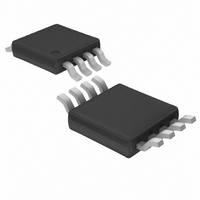LTC1966CMS8#TRPBF Linear Technology, LTC1966CMS8#TRPBF Datasheet - Page 18

LTC1966CMS8#TRPBF
Manufacturer Part Number
LTC1966CMS8#TRPBF
Description
IC PREC RMS/DC CONV MCRPWR 8MSOP
Manufacturer
Linear Technology
Specifications of LTC1966CMS8#TRPBF
Current - Supply
155µA
Voltage - Supply
2.7 V ~ 5.5 V
Mounting Type
Surface Mount
Package / Case
8-MSOP, Micro8™, 8-uMAX, 8-uSOP,
Lead Free Status / RoHS Status
Lead free / RoHS Compliant
Available stocks
Company
Part Number
Manufacturer
Quantity
Price
But with 100µF , the settling time to even 10% is a full 38
seconds, which is a long time to wait. What can be done
about such a design? If the reason for choosing 100µF is
to keep the DC error with a 75mHz input less than 0.1%,
the answer is: not much. The settling time to 1% of 76
seconds is just 5.7 cycles of this extremely low frequency.
Averaging very low frequency signals takes a long time.
However, if the reason for choosing 100µF is to keep the
peak error with a 10Hz input less than 0.05%, there is
another way to achieve that result with a much improved
settling time.
Reducing Ripple with a Post Filter
The output ripple is always much larger than the DC er-
ror, so filtering out the ripple can reduce the peak error
substantially, without the large settling time penalty of
simply increasing the averaging capacitor.
Figure 13 shows a basic 2nd order post filter, for a net 3rd
order filtering of the LTC1966 RMS calculation. It uses the
85kΩ output impedance of the LTC1966 as the first resistor
of a 3rd order Sallen-Key active RC filter. This topology
features a buffered output, which can be desirable depend-
ing on the application. However, there are disadvantages
to this topology, the first of which is that the op amp input
voltage and current errors directly degrade the effective
LTC1966 V
errors for four of Linear Technology’s op amps.
LTC1966
applicaTions inForMaTion
18
LTC1966
OOS
5
6
LTC1966 V
TOTAL OFFSET
. The table inset in Figure 13 shows these
R
Figure 13. Buffered Post Filter
OP AMP
I
B/OS
B
V
VALUE
I
IOS
SQ
• R
OOS
38.3k
C
1µF
R1
AVE
±375µV
±648µV
LT1494
±73µV
294k
1µA
169k
R2
1µF
C1
LT1880
±150µV
±329µV
±679µV
SHORT
1.2mA
±200µV
C2
0.1µF
±329µV
±589µV
LT1077
±60µV
48µA
294k
–
+
LT1880
LT2050
±230µV
SHORT
750µA
±27µV
±3µV
R
B
1966 F13
A second disadvantage is that the op amp output has
to operate over the same range as the LTC1966 output,
including ground, which in single supply applications is
the negative supply. Although the LTC1966 output will
function fine just millivolts from the rail, most op amp
output stages (and even some input stages) will not.
There are at least two ways to address this. First of all,
the op amp can be operated split supply if a negative
supply is available. Just the op amp would need to do so;
the LTC1966 can remain single supply. A second way to
address this issue is to create a signal reference voltage a
half volt or so above ground. This is most attractive when
the circuitry that follows has a differential input, so that
the tolerance of the signal reference is not a concern. To
do this, tie all three ground symbols shown in Figure 13
to the signal reference, as well as to the differential return
for the circuitry that follows.
Figure 14 shows an alternative 2nd order post filter, for
a net 3rd order filtering of the LTC1966 RMS calculation.
It also uses the 85kΩ output impedance of the LTC1966
as the first resistor of a 3rd order active RC filter, but this
topology filters without buffering so that the op amp DC
error characteristics do not affect the output. Although the
output impedance of the LTC1966 is increased from 85kΩ
to 285kΩ, this is not an issue with an extremely high input
impedance load, such as a dual slope integrating ADC like
the ICL7106. And it allows a generic op amp to be used,
such as the SOT-23 one shown. Furthermore, it easily
works on a single supply rail by tying the noninverting
input of the op amp to a low noise reference as optionally
shown. This reference will not change the DC voltage at
the circuit output, although it does become the AC ground
for the filter, thus the (relatively) low noise requirement.
LTC1966
Figure 14. DC Accurate Post Filter
5
6
REF VOLTAGE,
SEE TEXT
OTHER
C
1µF
200k
R1
AVE
C1
0.22µF
–
+
LT1782
681k
R2
C2
0.22µF
1066 F14
1966fb













